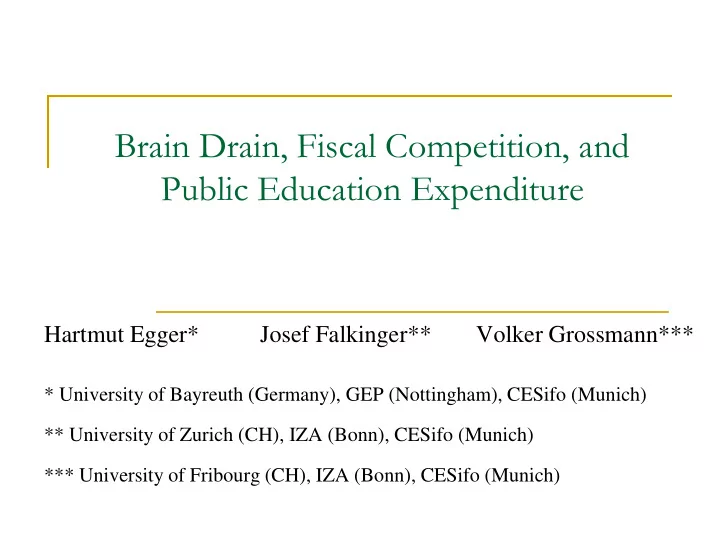

Brain Drain, Fiscal Competition, and Public Education Expenditure Hartmut Egger* Josef Falkinger** Volker Grossmann*** * University of Bayreuth (Germany), GEP (Nottingham), CESifo (Munich) ** University of Zurich (CH), IZA (Bonn), CESifo (Munich) *** University of Fribourg (CH), IZA (Bonn), CESifo (Munich)
Motivation Increasing mobility of skilled labor In 1990, 12.5 million tertiary educated lived in OECD In 2000, increase to 20.4 million Half of them migrated to US (Docquier and Marfouk, 2006) High emigration rates in Caribbean (42.7%), Central America (16.9%), Sub-Saharan Africa (13.1%), but also in some European countries Problem of public education finance In OECD, 73,1% of tertiary education expenditure publicly financed in year 2005 (EU19: 82.5%) High public education spending makes country prone to brain drain fiscal competition Higher emigration reduces tax base in source country and increases it in host country, triggering further migration agglomeration effects
Motivation Main features of our analysis: Multiple equilibrium Economies may differ in total factor productivity (TFP) Questions: Race to the bottom regarding public education system in fiscal competition? Does policy coordination among national governments necessarily improve social welfare? Are public expenditure levels everywhere higher in social optimum compared to non-cooperative policy setting? Direction of migration flows role of asymmetry? Is policy coordination more or less likely to involve migration than non-cooperative policy setting? May policy coordination reverse direction of migration flow? Is direction of migration flow under coordination socially optimal?
Related Literature Tax system Less progressive income taxation (e.g. Wildasin, 2000) Emigration tax (e.g. Bhagwati and Wilson, 1989; Poutvaara, 2004) Inefficient policy setting vs. curbing excessive taxation (Anderson and Konrad, 2003) Human capital formation – brain gain: Mountford (1997) Beine, Docquier and Rapoport (2001, 2008) Public education system Under-provision (Justman und Thisse, 1997, 2000) in symmetric equilibrium. But: “the most interesting problems may arise in asymmetric cases” Argument for coordinated policy (e.g. Council of Europe, 1995, 2000)
The Model 2 countries (or jurisdictions), H ome and F oreign Homogenous good ( Y ) produced under perfect competition with low-skilled ( L ) and skilled ( S ) labor: j j j j 1 j Y A ( S ) ( L ) , A 0 , j H , F Individuals choose whether to acquire higher education (at identical time costs) whether to migrate (if educated) Individuals may differ in migration costs Utility at home: U=c (consumption level) Utility abroad: U=c/ (1+ θ ) for fraction q , U=0 for fraction 1- q (labor market integration lowers θ >0 )
The Model H G F Government choose education expenditure , G H F , proportional income taxation (balanced public budget): tax rate j higher enhances efficiency units of a skilled worker born in j H , F G whether working at home or abroad Skilled individuals in H migrate if relative net wage per efficiency unit abroad sufficiently high: F F ( 1 ) w S 1 H H ( 1 ) w S increases when migration H F , decreases when F H agglomeration effects from taxation: multiple equilibria H F is increasing in , decreasing in G G
Facing Brain Drain: How Much Scope for Policy? H G F H ( G , G ) : 1 if no migration F G H ( G , ) : 1 if no migration H F 1 /( 1 ) slope ( A / A ) triggers migration H F F H ( G , G ) : 1 if migration H F avoids migration H F F G F G
Education Expenditure under Fiscal Competition Each government maximizes welfare of median voter (who is non-migrant), by choosing G -level (given G -level abroad) Under “ stay-home ” beliefs if θ is high, only an equilibrium w/o migration exists autarky G -levels (optimal) if θ is low, no equilibrium exists (“race to the bottom”) Under “ go-abroad ” beliefs if θ is high, again, only equilibrium w/o migration possible if θ is low, only an equilibrium with migration is possible under-provision
Optimal Policy Setting for Given Migration Pattern W H (=welfare of non-migrant in H ) H W F H H W 0 H W H F H G H H H G G G H F 0 F H
International Policy Coordination Governments bilaterally maximize sum of median voters’ coop H F welfare: W W W neglect of migrants: coordinated policy social planer solution Under “stay - home” beliefs: If θ is high, no role of coordination (no migration, autarky G -levels) If θ is low, coordination on autarky levels; overcomes race to the bottom Under “go - abroad” beliefs: Coordination may reverse migration flow Coordination raises total education spending, but may lower social welfare Social planer tends to concentrate spending on advanced country Education spending in less advanced country may be lower than in non-cooperative equilibrium Migration from more to less advanced country, in contrast to coordination outcome
Conclusion A jurisdiction with too ambitious education expenditure (relative to TFP) triggers brain drain Non-cooperative policy game may either lead to socially optimal outcome or to under-provision of public education may only lead to migration under go-abroad beliefs Policy coordination tends to avoid migration possibly reduces social welfare compared to non-cooperation Social planer tends to concentrate education expenditure on advanced country may reverse migration flow compared to coordinated policy
Recommend
More recommend